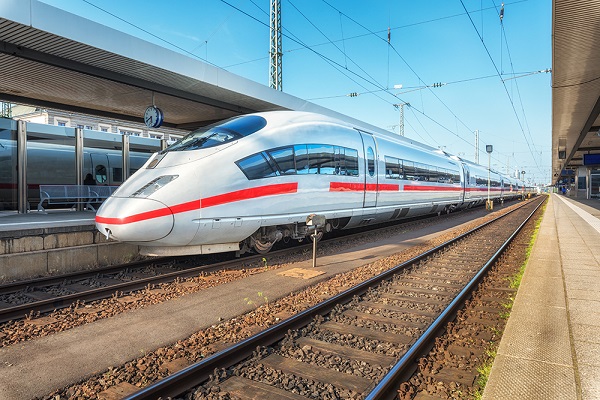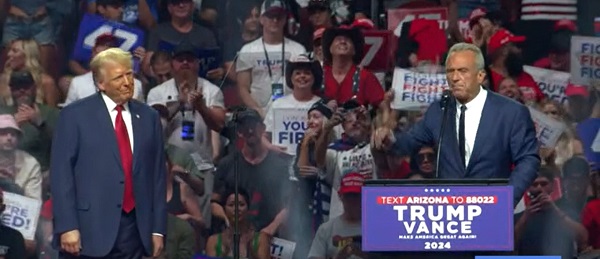Energy
Energy notes from the edge: Coal trains vs high speed rail

From the Frontier Centre for Public Policy
Author Terry Etam is a columnist with the BOE Report
They are accusing you of murdering people by producing fuel the world requires for survival. It’s silly; they (the NDP) have things precisely backwards – they are confused by the role of hydrocarbons in our life. So you need to address that first and foremost, because they are writing policy based on such faulty reasoning.
They are NOT asking you to produce your product better. They are saying you are killing the planet and its people and making a fortune while doing so.
Ah, you couldn’t make this stuff up, as we find ourselves saying on a daily basis.
Here’s a look at two ambitious infrastructure projects involving rail construction, separated by a few years and also by about everything else two projects could be separated on. One of the train stories dates way back to 2019; let me take you back to that era for all the readers less than five years old (not quite but close; last week I met a delightful family, a mother and two young daughters that are fascinated by pump jacks, love taking pictures of them, and are planning to launch an apparel line adorned by nodding donkeys. I’ll take five.) 2019 was the zenith of anti-hydrocarbon frenzy. It remains alive in small pockets of guilt-ridden billionaire inheritors and various political types that don’t understand energy and don’t want to learn, but 2019 was something else; hundreds of thousands of brainwashed children taking to the streets behind a strange Swedish kid that was treated like a messiah by confused adults. Canada’s prime minister jauntily joined one of her protests, standing proudly in front of signs explaining in emotional gobbledygook that the hydrocarbons that were keeping the sign-holders alive now and for the foreseeable future had to be eradicated immediately via some demand or magic or else the world will simply explode into flames a few decades hence.
Anyway, it was all surreal in one sense, but back to the railways: a few interesting milestones were hit around then that, when viewed alongside the climate hysteria of the era, prove without a doubt just how challenging it will be to transition to a new energy system.
But before getting to the 2019 story, we’ll check in on one that began long before then and continues to this day. It hails from sunny California, spiritual leader of the Movement To Use Extreme Wealth To Do Wacko Things. In 2008, voters approved a high-speed rail connection between Los Angeles and San Francisco, to be completed by 2020, at a cost of some $33 billion. Big numbers, both on the timescale and in the $ department. That’s reality these days though; nothing is easy or cheap, part of which is the price of going green. US energy transition advocates have reliably pointed out that high speed rail was a necessity all over the US, and the world for that matter. Nature website ran an article stating “…the role of high-speed railways in fostering a transition towards sustainable energy sources has gained prominence… these findings highlight the environmentally friendly attributes of high-speed railways and underscore the pressing need for effective policy measures to facilitate a global transition towards renewable energy, both in China and worldwide.”
A few interesting tidbits emerge out of this scenario. The first and most peculiar is that a scientific article on the scientific website Nature would assert that high-speed rail is important in “fostering a transition towards sustainable energy sources” – the statement has no logical basis, it flows from nothing, and is incoherent. HSR is wonderful, and makes efficient use of time, and possibly could replace air travel in some circumstances, and, as the paper rightly asks, HSR may well contribute to ‘nationwide energy savings and emissions reductions’. But none of these virtues foster a transition towards sustainable energy sources and to state it does is an oddly dumb non sequitur to feature as the anchor statement for an academic paper.
But anyways, whatever, the paper analyzes China’s experiences with HSR, which brings up a far more interesting point about the energy transition that is in the realm of That Which Must Not Be Discussed: the fact that in the west, major infrastructure projects are incredibly difficult to construct, whether green or not, and that initial cost estimates often turn out to be laughably low.
California did indeed set out to build an HSR in 2008, to be completed (as you may recall) some twelve years hence. But, as this California news website notes, “the blueprint is fraying”, which is some beautiful understatement. In 2020, the year the project was to be completed, Governor Newsom unveiled an updated plan, that California would settle for building a 171 mile initial segment – about a third of the distance of the original – at a cost of $35 billion, a number that exceeds the initial estimate for the entire 500 mile line. And the in-service date for the shortened version is now penciled in as 2030. As for an end date for the entire project, they haven’t a clue, don’t even bother taking a guess at it, but they have bravely provided an updated budget of, brace yourself, $128 billion. That’s almost four times the original estimate.
And even that number is scoffed at by engineers that have worked on HSRs. Bill Ibbs, a retired UC Berkeley engineer, says he is concerned about the lack of attention to engineering risks – that proponents don’t even address significant engineering challenges in the latest cost estimate, such as challenges likely to arise in the 38 miles of mountain tunnels required. (Per the article linked above: “Democratic leaders have declined or did not respond to requests for interviews.” Who saw that coming.)
That is what we are in store for in the western world. Keep this example in mind the next time you hear about net-zero 2050 visions based on almost any large scale infrastructure construction. You would have to be the world’s most naïve person to believe initial cost and time estimates.
Now, on the other hand, countries such as China have indeed made great progress though, as we’ll see in a second, the choice of China as an example is fairly ironic. The Nature academic paper notes that hundreds of Chinese cities already operate HSR networks. China has stunned the world with the pace at which it has developed infrastructure over the past 40 years; however, it is an authoritarian state that sweeps aside the sort of issues that bog down western democracies like a bear sweeps aside a hiker.
And if we’re going to marvel at the speed at which China has constructed these HSRs, then we should look at this one too. In 2019, China opened a brand new, 1,813 mile railroad, completed on schedule at a cost of $28 billion. It took 4 years to construct, and faced multiple significant challenges such as “crossing both the Yangtze and Yellow Rivers twice” and includes 770 bridges and 229 tunnels totalling 469 kilometres or 291 miles, some 8 times as many tunnel miles as California. This new rail line is dedicated to carrying… coal. It was created for no other reason. It was built entirely to handle coal.
That’s how they do it folks. An authoritarian state that removes any obstacles instantly, all to build a supply line for a fuel that the west is cleansing itself from as fast as it can. China realizes what it takes to build things. The West does not. Further, while China is the largest installer of renewable energy, it is fairly transparent about its appetite for any fuel. That’s how the world works, folks, except for some…
“How do you sleep at night?” Or… how to win a debate with extremist loons – hand them a microphone.
An NDP committee that hates things dragged a bunch of “Big Oil” (or “Big Canadian Oil”, anyway) CEOs onto the carpet to, literally, blame them for forest fires and floods. Their argument went about where you’d think it would, when your philosophical underpinnings are of that grade: Not only do you mooks create a lot of bad weather, but you line your pockets by doing so, gleefully so, and thus we want to know just how you can sleep at night.
The CEOs responded decently enough in their polished way, but I think it’s important when addressing an interrogation of that sort to firmly call out the lay of the land.
Rich Kruger, CEO of Suncor, said “I could praise the transformational virtues of hydrocarbons over the past century, convey the world’s dependence on oil and gas for decades to come, recite economic contributions to Canada’s prosperity and, yes, discuss the concerning effects of climate change and GHG emissions… however, today, I plan to dispel a series to myths. And paint a picture of opportunity.” The myths: oil & gas prosperity comes at the expense of the planet; Canadian companies are resisting the energy transition/decarbonization; and that Canada can demonstrate global leadership by restricting its oil & gas sector.
He’s not wrong, but there’s a significant subtlety that gets swept under the rug here, one that can cause grave danger to a lot of people.
First, y’all need to understand the battlefield. Kruger is right; it is to generate headlines, but consider the headlines carefully when selecting which myths to bust. They (the NDP) are literally accusing the hydrocarbon industry of murder – not with a gun, but via creating the emissions that cause weather disasters that kill people. They and their fellow warriors have created a lazy but sellable chain of causality there.
Mythbusting is important, but first, it is critical to take aim at the cornerstones of their argument, and not capitulate on those. In other words:
- If someone accuses you of killing a bunch of people, might I suggest that saying “Yeah, well, we pay a lot of taxes…” is a losing strategy?
- If someone accuses you of killing a bunch of people, might I suggest that saying “Don’t worry, I’m taking measures to mitigate how many people I kill.” is also a losing strategy?
- Absolutely speak of emissions reduction improvements and any efforts made towards an energy transition – but don’t ignore the emotional point they use, when it undercuts everything else you say.
They are accusing you of murdering people by producing fuel the world requires for survival. It’s silly; they (the NDP) have things precisely backwards – they are confused by the role of hydrocarbons in our life. So you need to address that first and foremost, because they are writing policy based on such faulty reasoning.
They are NOT asking you to produce your product better. They are saying you are killing the planet and its people and making a fortune while doing so.
Their army of lawyers, with literally nothing better to do (hello, Sierra Club/Environmental Defense/EcoJustice/ad infinitum) are running circles around your lawyers. You are facing an army of extremely well-funded legal guerillas. You need to recognize their weapons. You are fighting against rifles with a diorama of your decarbonization efforts.
Here is the answer that addresses the inanity of the question in a simple and fool-proof way, which will do the trick, because they will have no answer: Hydrocarbon production enables life as we know it. Without hydrocarbon production, most of the earth’s 8 billion people will not survive a year. Hydrocarbon production feeds those people in a way that nothing else can. Hydrocarbon production keeps countless people from freezing to death, every year, like nothing else at present can. Hydrocarbon production provides the building blocks for our modern medical system, our transportation system, and almost any other thing within arm’s length.
Hydrocarbon production enables life, and it will do so for decades until a suitable replacement arrives on the scene that can not just match, but beat hydrocarbons for energy density, reliability, and cost. That will most likely happen some day. But to attempt to strangle today’s fuel system without a replacement is a clearer path to willfully causing human death than is the production of the fuel that keeps us alive.
There are multiple excellent pathways a hydrocarbon company can go down to show the public they are validly concerned about the environment, such as eliminating spills, eliminating pollution of all sorts, or respecting and revitalizing natural habitats.
But when you tell them how eagerly you are ‘decarbonizing’, you forfeit the match. Your product is carbon. That is literally the murder weapon they place in your hands.
The impact on humanity from more carbon in the air, whatever the consequences may be, pales in comparison – by an astounding degree – to what the impact on humanity would be if oil and gas production were to cease.
Mr. Kruger touched on the most important part, but then skipped right over it: the “transformational virtues of hydrocarbons over the past century”, as a phrase, skips right over the entire arc of the human benefits brought through the industrial revolution, treating them as secondary aspect that needs to take a back seat to convincing the world that Canadian companies really are trying to decarbonize.
And let’s be clear about that whole idea: anyone that places decarbonization as the number one priority should drop whatever they’re doing to get out and make nuclear energy happen here, there, and everywhere, because that’s the only game in town as far as a global, achievable solution goes. I don’t have a problem with that. I love cheap, clean energy, available reliably and in abundance. And almost every global citizen would agree with those four, but more importantly would prefer all four, of those characteristics. People don’t love oil & gas. They love what it can do. Want to replace them? Then it has to be better in every functional way.
While the fate of oil/gas on the global stage will be determined by billions who know how much they need it, the emotional messaging of the NDP et al nevertheless has the power to shape legislation, for example to sneakily introduce climate reporting requirements into financial statements and thereby open the door to countless lawsuits – lawsuits which the industry will be forced to defend. And those singular-function activist-lawyers will eat you alive if you are sitting at the table agreeing about the need to rapidly decarbonize.
The messaging should be that humanity requires oil and gas and will for decades, and that role of industry is to do this as cleanly and efficiently as possible. That might sound like a subtle distinction compared to a pledge to decarbonize asap, but it’s not – it’s the difference between a bullet missing you by an inch and not.
The reason you need to think this way is because hydrocarbons will remain standing for a very long time as a fundamental source of energy, as is witnessed by the sheer global force of increasing consumption of every type of energy (see: New Zealand completely backtracking on an oil & gas exploration ban once it dawned on them that existing fields deplete – coming soon to governments everywhere)… But Western energy leaders may get seriously wounded by the sheer legal might of the enemies faced at such panels, and by the minions they inspire, as bombastically comical as it might appear on the surface.
Terry Etam is a columnist with the BOE Report, a leading energy industry newsletter based in Calgary. He is the author of The End of Fossil Fuel Insanity. You can watch his Policy on the Frontier session from May 5, 2022 here.
Business
The world is no longer buying a transition to “something else” without defining what that is

From Resource Works
Even Bill Gates has shifted his stance, acknowledging that renewables alone can’t sustain a modern energy system — a reality still driving decisions in Canada.
You know the world has shifted when the New York Times, long a pulpit for hydrocarbon shame, starts publishing passages like this:
“Changes in policy matter, but the shift is also guided by the practical lessons that companies, governments and societies have learned about the difficulties in shifting from a world that runs on fossil fuels to something else.”
For years, the Times and much of the English-language press clung to a comfortable catechism: 100 per cent renewables were just around the corner, the end of hydrocarbons was preordained, and anyone who pointed to physics or economics was treated as some combination of backward, compromised or dangerous. But now the evidence has grown too big to ignore.
Across Europe, the retreat to energy realism is unmistakable. TotalEnergies is spending €5.1 billion on gas-fired plants in Britain, Italy, France, Ireland and the Netherlands because wind and solar can’t meet demand on their own. Shell is walking away from marquee offshore wind projects because the economics do not work. Italy and Greece are fast-tracking new gas development after years of prohibitions. Europe is rediscovering what modern economies require: firm, dispatchable power and secure domestic supply.
Meanwhile, Canada continues to tell itself a different story — and British Columbia most of all.
A new Fraser Institute study from Jock Finlayson and Karen Graham uses Statistics Canada’s own environmental goods and services and clean-tech accounts to quantify what Canada’s “clean economy” actually is, not what political speeches claim it could be.
The numbers are clear:
- The clean economy is 3.0–3.6 per cent of GDP.
- It accounts for about 2 per cent of employment.
- It has grown, but not faster than the economy overall.
- And its two largest components are hydroelectricity and waste management — mature legacy sectors, not shiny new clean-tech champions.
Despite $158 billion in federal “green” spending since 2014, Canada’s clean economy has not become the unstoppable engine of prosperity that policymakers have promised. Finlayson and Graham’s analysis casts serious doubt on the explosive-growth scenarios embraced by many politicians and commentators.
What’s striking is how mainstream this realism has become. Even Bill Gates, whose philanthropic footprint helped popularize much of the early clean-tech optimism, now says bluntly that the world had “no chance” of hitting its climate targets on the backs of renewables alone. His message is simple: the system is too big, the physics too hard, and the intermittency problem too unforgiving. Wind and solar will grow, but without firm power — nuclear, natural gas with carbon management, next-generation grid technologies — the transition collapses under its own weight. When the world’s most influential climate philanthropist says the story we’ve been sold isn’t technically possible, it should give policymakers pause.
And this is where the British Columbia story becomes astonishing.
It would be one thing if the result was dramatic reductions in emissions. The provincial government remains locked into the CleanBC architecture despite a record of consistently missed targets.
Since the staunchest defenders of CleanBC are not much bothered by the lack of meaningful GHG reductions, a reasonable person is left wondering whether there is some other motivation. Meanwhile, Victoria’s own numbers a couple of years ago projected an annual GDP hit of courtesy CleanBC of roughly $11 billion.
But here is the part that would make any objective analyst blink: when I recently flagged my interest in presenting my research to the CleanBC review panel, I discovered that the “reviewers” were, in fact, two of the key architects of the very program being reviewed. They were effectively asked to judge their own work.
You can imagine what they told us.
What I saw in that room was not an evidence-driven assessment of performance. It was a high-handed, fact-light defence of an ideological commitment. When we presented data showing that doctrinaire renewables-only thinking was failing both the economy and the environment, the reception was dismissive and incurious. It was the opposite of what a serious policy review looks like.
Meanwhile our hydro-based electricity system is facing historic challenges: long term droughts, soaring demand, unanswered questions about how growth will be powered especially in the crucial Northwest BC region, and continuing insistence that providers of reliable and relatively clean natural gas are to be frustrated at every turn.
Elsewhere, the price of change increasingly includes being able to explain how you were going to accomplish the things that you promise.
And yes — in some places it will take time for the tide of energy unreality to recede. But that doesn’t mean we shouldn’t be improving our systems, reducing emissions, and investing in technologies that genuinely work. It simply means we must stop pretending politics can overrule physics.
Europe has learned this lesson the hard way. Global energy companies are reorganizing around a 50-50 world of firm natural gas and renewables — the model many experts have been signalling for years. Even the New York Times now describes this shift with a note of astonishment.
British Columbia, meanwhile, remains committed to its own storyline even as the ground shifts beneath it. This isn’t about who wins the argument — it’s about government staying locked on its most basic duty: safeguarding the incomes and stability of the families who depend on a functioning energy system.
Resource Works News
Energy
Tanker ban politics leading to a reckoning for B.C.

From Resource Works
That a new oil pipeline from Alberta to BC is being aired by Ottawa and pushed by Alberta has, in turn, critics eagerly pushing carefully crafted scare stories.
Take the Green Party’s Elizabeth May, for one: She insists that oil tankers leaving Prince Rupert would be sailing through “Canada’s most dangerous waters and the fourth most dangerous waters in the world.”
First, this “dangerous waters” claim is unsubstantiated, unproven, and hyperbolic. It is apparently based on a line in a 1992 federal guide to marine-weather hazards on the west coast, but it is not credited or supported there.
Second, who says a new oil pipeline would go to Prince Rupert? No destination is specified in the memorandum of understanding published by Ottawa and Alberta.
It speaks of a commitment to “enable the export of bitumen from a strategic deep-water port to Asian markets.”
Energy Minister Tim Hodgson: “There is no route today. Under the MoU, what (Alberta) would need to do is work with the affected jurisdiction, British Columbia, and work with affected First Nations for that project to move forward. That’s what the work plan in the MoU calls for.”
First Nations concerned
Now, the MoU does say that this could include “if necessary” a change to the federal ban on oil tankers in northwest BC waters.
Some First Nations are strongly fighting the idea of oil tankers in northern BC waters citing fears of a catastrophic spill. The Assembly of First Nations (AFN), for example, is calling for the Canada-Alberta pipeline MoU to be scrapped.
“A pipeline to B.C.’s coast is nothing but a pipe dream,” said Chief Donald Edgars of Old Massett Village Council in Haida Gwaii.
And AFN National Chief Cindy Woodhouse Nepinak said: “Canada can create all the MOUs, project offices, advisory groups that they want: the chiefs are united. . . When it comes to approving large national projects on First Nations lands, there will not be getting around rights holders.”
Alberta group interested
But the Metis Settlements of Alberta say they’re interested in purchasing a stake in the proposed pipeline and want to “work with First Nations in British Columbia who oppose the project.”
The Alberta government’s Indigenous loan agency says a new oil pipeline to the BC coast could deliver “significant” returns for Indigenous Peoples.
Alberta Premier Danielle Smith has suggested the pipeline could bring in $2 billion a year in revenue, and that it could be as much as 50 per cent owned by Indigenous groups — who would thus earn $1 billion a year,
“Can you imagine the impact that would have on those communities in British Columbia and in Alberta? It’s extraordinary.”
And we note that in 2019 the First Nations-proposed Eagle Spirit Energy Corridor, which aimed to connect Alberta’s oilpatch to Kitimat, garnered serious interest among Indigenous groups. It had buy-in from 35 First Nations groups along the proposed corridor, with equity-sharing agreements floated with 400 others. (The project died with passage of the tanker ban.)
Vancouver more likely
More recent chatter, including remarks by BC Premier David Eby, would suggest oil from a new pipeline would more likely be through Vancouver, rather than via Prince Rupert or Kitimat BC. And tankers have been carrying oil from the Trans Mountain Pipeline System’s Burnaby terminal since 1956 — with no spills.
Oft cited by northern-port opponents is the major spill of 258,000 barrels of crude oil (more than 40 million litres) from the tanker Exxon Valdez, which ran aground in Alaska’s Prince William Sound in 1989.
The resulting spill killed native and marine wildlife over 2,100 km of coastline. The U.S. National Transportation Safety Board found that the spill occurred due to human error. It cited a tired third mate on watch, and noted the captain had an alcohol problem.
But the Exxon Valdez was a single-hull tanker. Its spill led to the phasing out of single-hull tankers, replaced in the ensuing 36 years by new generations of double-hull vessels (with an inner and outer hull separated to contain spills if the outer hull ruptures), new tanker safety rules — and new ways of dealing with the far-fewer spills.
Among those new ways is the Western Canada Marine Response Corporation: “Our mandate is to ensure there is a state of preparedness in place when a marine spill occurs and to mitigate the impacts on B.C.’s coast. This includes the protection of wildlife, economic and environmental sensitivities, and the safety of both responders and the public.”
What about LNG carriers?
At the same time, fear-mongers are actively flogging scare stories on social media.
One opposition group sees future LNG carrier traffic along the southern BC coast as potentially numbering “in the realm of 800+ transits a year.”
Eight hundred a year? BC Ferries runs more than 185,000 a year. And the ferries don’t have tethered tugs helping them to get safely from LNG terminals. And they don’t have BC Coast Pilots on the bridge to keep progress safe. Oil tankers leaving the Port of Vancouver have both.
As marine captain Duncan MacFarlane of LNG Canada in Kitimat says: “LNG carriers are some of the most sophisticated ships in the world…Once loading operations are complete (at LNG Canada), three BC Pilots will join the ship and start navigating up the Douglas Channel, which is approximately 159 nautical miles out to the Prince Rupert pilot station.”
“LNG Canada has partnered with HaiSea Marine, which is a company formed between the Haisla Nation and Vancouver-based SeaSpan, to provide two escort tugs and three harbour-assist tugs to safely move the vessel out of the Douglas Channel…once the vessel drops the pilots at Prince Rupert, it starts a seven- to ten-day voyage to its discharge port. To assist with this, they’ll use satellite navigation, weather routing, and a variety of other technologies to get to their port the safest and most efficient way.”
The same would apply to oil tankers from any northern port in BC.
BC’s tanker-safety record
As the small-c conservative Fraser Institute points out: “Pipelines are 2.5 times safer than rail for oil transportation, and oil tankers have [the] safest record of all.”
And it adds: “The history of oil transport off of Canada’s coasts is one of incredible safety, whether of Canadian or foreign origin, long predating federal Bill C-48’s tanker ban. . . .new pipelines and additional transport of oil from (and along) B.C. coastal waters is likely very low environmental risk. In the meantime, a regular stream of oil tankers and large fuel-capacity ships have been cruising up and down the B.C. coast between Alaska and U.S. west coast ports for decades with great safety records.”
This last refers to the 200-230 tankers a year that now carry crude oil from Alaska through Canadian waters south of Haida Gwaii and then down BC’s Inside Passage or outer coastal waters to Juan de Fuca Strait and Washington refineries.
While these tankers do not transit Hecate Strait (the north end of which is the area of concern about spills from tankers from Prince Rupert or Kitimat) all these US tankers are double-hulled, must report positions, speeds and routes in real-time, must carry certified pilots, must use traffic-separation routes (like traffic lanes), and must slow to 11 knots in sensitive areas.
And as Pipeline Action says: “Canada is not inferior — If Norway can move tankers safely through fjords, if Japan can operate in some of the busiest waterways on Earth, if Alaska balances ecological protection with responsible shipping and if Eastern Canadian ports manage tankers every day, then Canada’s West Coast, with its governance standards, technical capacity and Indigenous partnership potential, can certainly do so.”
Resource Works News
-

 National1 day ago
National1 day agoCanada’s free speech record is cracking under pressure
-

 Digital ID20 hours ago
Digital ID20 hours agoCanada considers creating national ID system using digital passports for domestic use
-

 Business1 day ago
Business1 day agoAlbertans give most on average but Canadian generosity hits lowest point in 20 years
-

 Crime2 days ago
Crime2 days agoU.S. seizes Cuba-bound ship with illicit Iranian oil history
-

 Daily Caller2 days ago
Daily Caller2 days agoUS Supreme Court Has Chance To End Climate Lawfare
-

 Business1 day ago
Business1 day agoTaxpayers Federation calls on politicians to reject funding for new Ottawa Senators arena
-

 COVID-192 days ago
COVID-192 days agoTrump DOJ seeks to quash Pfizer whistleblower’s lawsuit over COVID shots
-

 Bruce Dowbiggin1 day ago
Bruce Dowbiggin1 day agoCarney Hears A Who: Here Comes The Grinch









